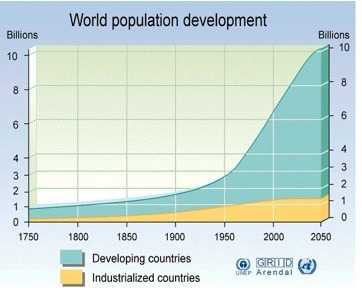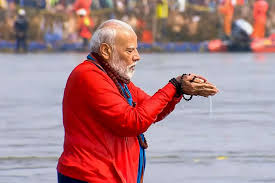
Population explosion refers to a rapid and dramatic increase in the size of the population of a country within short period of time. It typically occurs when the birth rate significantly exceeds the death rate. The characteristics of population explosion are high birth rate, low death rate due to advancement of medicine and technology, strain on resources such as food, water, housing, and employment. There is also increased pressure on infrastructure, education and health care systems. India’s population growth since gaining independence in 1947 has been significant, transitioning from a relatively small population (approx. 34 crore) to becoming the most populous country (approx. 143 crore) in the world by 2023 (Source: Department of ESA, UN). Paul R. Ehrlich in his book “Population Bomb” advocated for an “unprecedented redistribution of wealth” globally , in order to mitigate the problem of overconsumption of resources by the world’s wealthy countries. Despite its overall growth, India’s population dynamics today are little like those Ehrlich described. Food-security has been a major concern in India. In 2022, the Global Food Security Index (GFSI) ranked India at 68th out of the 113 major countries in terms of food-security. GFSI is a quantitative and qualitative model that measures food security in 113 countries.
India surpassed China in April, 2023 as the world’s most populated country (Source: Department of ESA, UN) and fertility is the key driver of this population trend. In 1971, China and India had nearly identical levels of Total Fertility Rate (TFR), with just under six births per woman over a lifetime. Fertility in China fell sharply to fewer than three births per woman by the end of the 1970s. For India, it took three and a half decades (42 years) to experience the same fertility reduction that occurred in China over a seven-year period during the 1970s. India’s population growth is backed in from the past and driven by population momentum, which is the tendency of a population to keep growing even a fertility falls.
Economic growth is necessary for economic development of a country, but it is not sufficient on its own. A country may experience economic growth without development if the wealth is not evenly distributed or if the growth harms the environment or the social well-being. Economic growth refers to an increase in country’s output of goods and services over the time, typically measured by the growth in Gross Domestic Product (GDP) or Gross National Product (GNP). Whereas, economic development refers to a broader process of improving the quality of life and well-being of the people, encompassing economic growth, social progress and institutional improvements. The indictors for economic development are as below:
• Human Development Index (HDI)
• Literacy rate
• Life expectancy
• Human Poverty Index (HPI)
• Access to Health Care and Education
India is in the middle of a demographic transition, with a large proportion of its population in the working-age group. This is often referred to as a demographic dividend, but it also creates challenges in terms of providing adequate education, jobs, and infrastructure. India’s current population (2024), over 1.44 billion (estimated), puts significant pressure on natural resources, healthcare, education, housing, and infrastructure. Some states, like Bihar, Odisha, Jharkhand, Meghalaya, Manipur and Uttar Pradesh, continue to have higher fertility rates and growth rates compared to southern states like Kerala, Telangana, Maharashtra and Tamil Nadu. There are disparities among the States in India as far as both economic growth and economic development. The contribution of the States in the national GDP is given in the chart-3(Source: TNPSC Current Affairs). The State share in national GDP is defined as ratio of State’s Gross State Domestic Product (GSDP) to sum of GSDP of all states. This gives an idea of relative economic importance of states. Among the Eastern States West Bengal, which held the third-largest share of national GDP at 10.5 percent in 1960-61, now accounts for only 5.6 percent in 2023-24. It has seen a consistent decline throughout this period. West Bengal’s per capita income was above the national average in1960-61 at 127.5 percent, but its growth failed to keep pace with national trends. As a result, its relative per capita income declined to 83.7 percent in 2023-24, falling below that of even traditionally laggard states like Rajasthan and Odisha. The Eastern part of India continues to be a concern.
The Kuznet’s curve (Fig. 4) suggests that as an economy develops income inequality first increases and then decreases, forming an inverted “U” shape. Here is a breakdown of the stages:
1. Early Development: In the initial stages of economic growth, industrialization and urbanization cause income inequality to rise. Rural population migrate to urban areas for jobs, but wealth distribution remains unequal.
2. Middle Stage: As industrialization progresses, disparities peak because, some sectors and individuals benefit more from the growth than others.
3. Later Development: Over time, as the economy matures and institutions (e.g., education, social welfare systems) strengthen, income inequality decreases. Wealth becomes more evenly distributed due to higher wages, better job opportunities, and redistributive policies. India is probably yet to cross the turning point (peak of the curve) in current economic development.
The 2024 Global Hunger Index shows that progress in combating global hunger remains inadequate. The GHI is calculated on a 100-point scale, with 0 being the best score and 100 being the worst. Though some countries have made headway, the 2024 GHI score for the world is 18.3, which is considered moderate. The goal of Zero Hunger by 2030, established by the Sustainable Development Goals, now appears unreachable. In 2024, India’s score on the Global Hunger Index (GHI) was 27.3, which is considered “serious”. This score ranks India 105th out of 127 countries.
According to the National Family Health Survey-5 (NFHS-5), 35.5% of children under the age of five in India were stunted, 19.3% were wasted, and 32.1% were underweight in 2019–2021. 7.7% of children under five were severely wasted. NFHS report comprises of detailed information on key domains of population, health and family welfare and associated domains like characteristics of the population; fertility; family planning; infant and child mortality; maternal and child health; nutrition etc. It shows the progress of different health indicators of the country. (Source: Global nutrition report 2021: NFHS-4 in 2015-16 and NFHS-5 in 2019-21)
India’s per capita GDP has increased since 1947, when it was around $58, to over $3,828 in 2023. In 1947, India’s GDP was $20 billion and its estimated population was 34 crore (approx..), which resulted in a per capita GDP of $58 (INR 5020). Total GDP of India was 3.7 trillion USD and per capita GDP was $2700 (INR 235978) in 2024. India’s economy has grown since 1947, and it is now the world’s fifth-largest economy by nominal GDP. The per capita GDP of South Korea and India was almost the same in 1947. In 2024, South Korea’s GDP per capita was $36,132 (INR 3157909). This is a reflection of the country’s strong economic output and high standard of living. In 2024, South Korea’s per capita GDP was 13.5 times than India. The main factor for greater per capita GDP of South Korea is population control. There various factors responsible for higher number of people in India are living below the poverty line are population explosion, caste system and social inequality, poor utilization of natural resources, gender disparities, illiteracy and unemployment, inadequate housing and sanitation etc. The World Bank defines the international poverty line has $2.15 per day (INR 188) for extreme poverty. However, at the rate of $3.65 (INR 315) per day poverty line, approximately 24.1% of India’s population is living below the poverty line in 2024. (Source: United Nations, Population Division, WPP 2017)
The curves (Fig. 7) compare the evolution of the population of Africa, China and India between 1950 and 2050. After 2015, they consist of the UN’s “average” projections. The logarithmic scale shows the evolution of the population through the slope of the curves. China’s growth slowed after 1990 (single child policy), and continues to slow until it diminishes around 2030; growth in India is sustained for longer and is forecast to overtake that of China in the 2020s; finally, Africa demonstrates stronger and more continuous growth, weakening just slightly after 2030.
India has an unequal distribution of wealth, with the top 1% of the population owning a large share of the country’s wealth. This inequality has been growing since the early 2000s. The top 1% of India’s population held 40% of the country’s wealth at the end of 2023. This is the highest concentration of wealth in the country’s richest 1% in six decades (Source: www.reuters.com). However, in 10 years, between 2014 to 2024, India’s per capita GDP rose from US$1438 (INR 125754) to over $2700 (INR 235978) — an increase of roughly 87% in ten years.
However, according to World Inequality Database, the top 1% of Indians owned 33% (2021) of the country’s wealth compared to 31.7% (2020). The top 10% own 64.6% of the country’s wealth, up from 63.9%. The share of the bottom 50% stands at 5.9%, down from 6% earlier.
Population growth can have a complex relationship with economic development, where rapid population growth (Countries like India, Brazil, Pakistan etc.) can hinder development by putting strain on resources like food, housing, and infrastructure, while a moderate population growth (Countries like USA, UK, Japan etc.) can potentially boost economic activity through a larger workforce and increased market demand, but the exact impact depends on factors like the country’s level of development, access to education, and quality of healthcare.
A population explosion in India is significantly related to its economic development by putting immense pressure on resources, leading to issues like high unemployment, low per capita income, strained infrastructure, and difficulty in providing essential services like healthcare and education, ultimately hindering the country’s overall economic growth; although a large population can sometimes be seen as a potential workforce, the lack of adequate skills and education can negate this benefit. India’s economic trajectory during the past decade has been remarkable, consistently surpassing global averages. In 2022/23, India’s GDP total was US$ 3.7 trillion and per capita was $2,612, marking a 11.67 % rise from the previous year’s $2,238 (2021/22).
Dr Sudarsan Mandal is a senior public specialist




